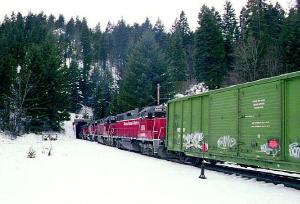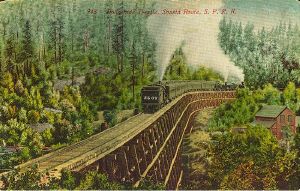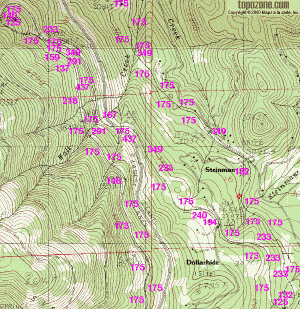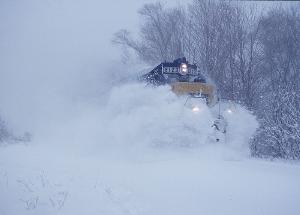Speed-Zone 11:
The Siskiyou Pass
Milepost 406.3 to Steinman
This is the slowest speed zone of the Siskiyou Line. Standard curve radius is 574 feet, the grade steepens from 3.3% to 3.67%, and both sides have loop curves with a radius of 410 feet. The slowest sections of an operation have a disproportionate effect on total average speed. Squeezing a few additional mph out of slow sections like this has a much higher effect than upgrading the Northern California Valley to 140 mph, at lower cost for the minute saved.

The Siskiyou summit with the northern portal of Tunnel 13, located 4122 feet above sea level.
Within this high mountain section, it won't be possible to use the full 6 inches of superelevation. Transitions from curve to curve are too short at several places, and even with additional power, the freight trains will be too slow, and damage the inner rail of fully superelevated track. 4 inches will probably be at the limit of possibilities. Additional obstacles will be tunnel 14, which has very tight clearances and might not allow any superelevation, and Wall Creek Viaduct. While the curve built into this viaduct is less sharp than many others, using high values of unbalanced superelevation might be impossible at the transition to the viaduct. When the Siskiyou Line was built, it has had lots of high trestles - wooden trestles. With the exception of the steel trestle above Wall Creek, all of them have been filled up, and are railroad dams today.

Passenger train on Dollarhide Trestle, about 100 years ago.
All the difficulties taken into account: If the suggested strategy, as outlined on page 36, is fully implemented, the situation isn't as bad as probably expected. Thanks to using all the unbalanced superelevation gained by tilting, average speed would be a little higher than in the Sacramento River Canyon, which is part of the current Amtrak route, and considerably faster than the "Coast Starlight" operates in that section today.

The trains will need acceleration ability on 3.4%, after passing a loop curve.
A detailed look at the Siskiyou Pass should explain, why requirements like "14 - 15 hp/ton of traction power" have been postulated on page 19, for the trains to use on the Shasta Route. After passing the tight loops, the trains have to accelerate back to the possible line speed of 43 mph, while on a 3.4% grade (northern side) or a 3.67% grade (southern side). If a traffic concept is based on standard Amtrak equipment, using the Siskiyou Line for passenger traffic isn't worth a second of consideration.
